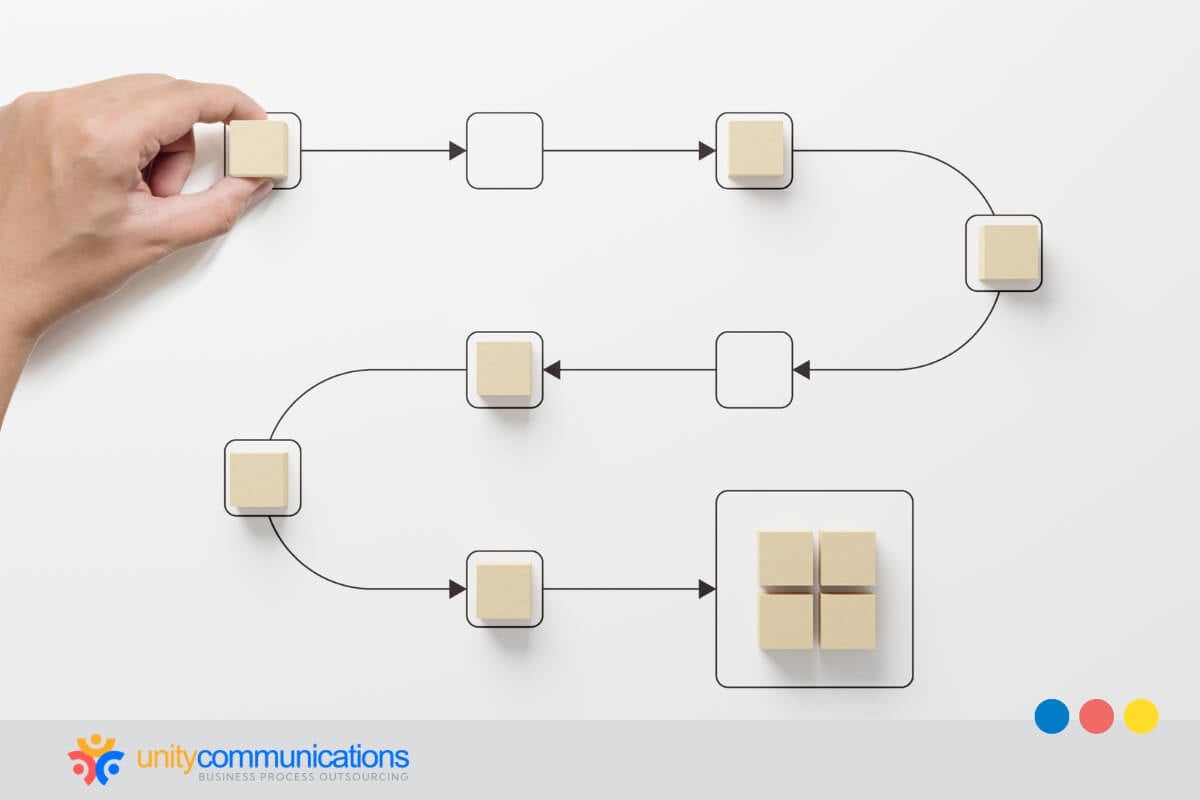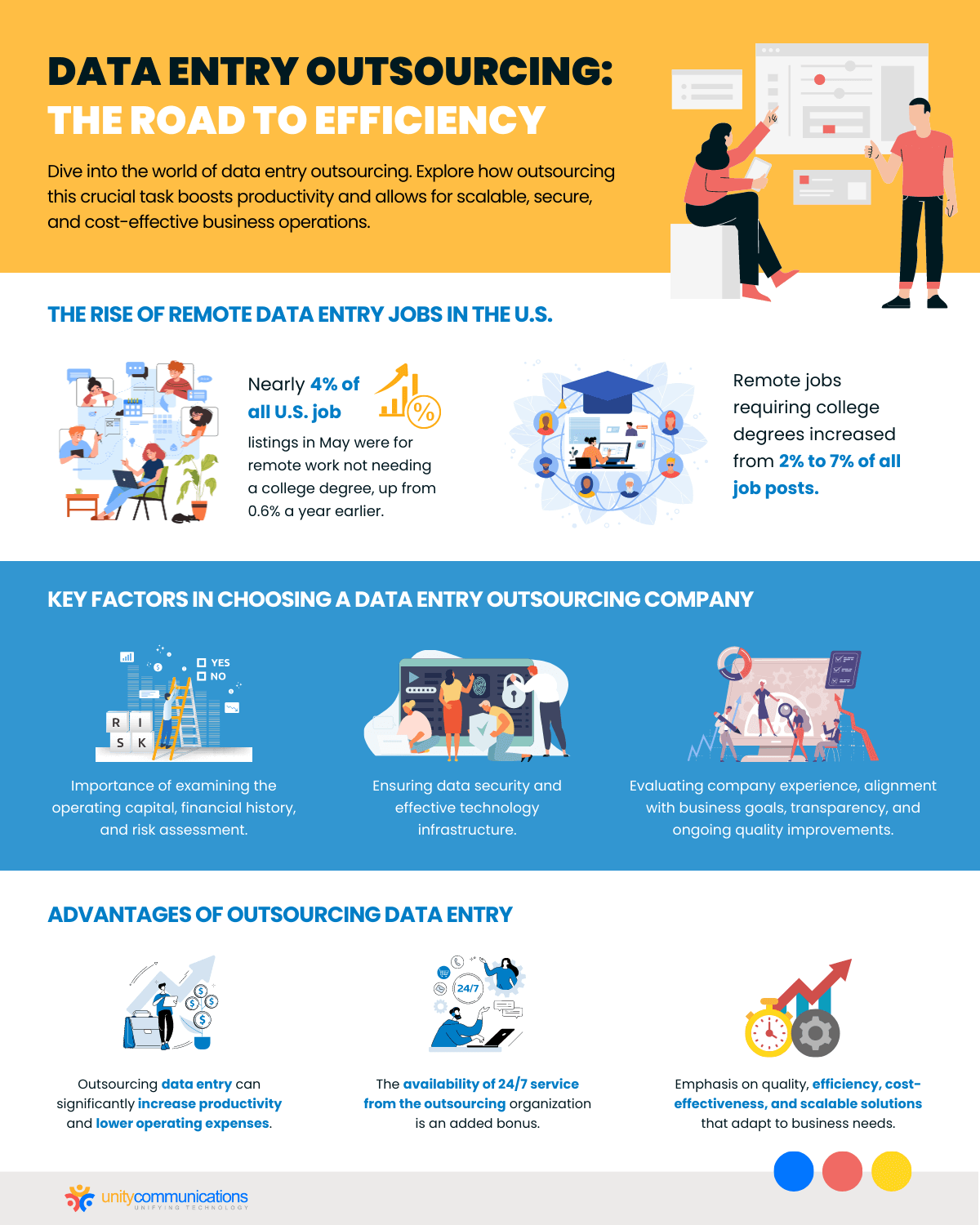Table of Contents
Data entry outsourcing services have become integral to today’s businesses. They seek efficiency and accuracy in data management tasks and delegate these to third-party contractors or business process outsourcing (BPO) providers.
By entrusting these tasks to a BPO provider, you can improve your organization’s overall performance and productivity while focusing on core operations.
This article teaches you how to choose the right data entry outsourcing provider and the six factors you should consider before outsourcing. These are cost-effectiveness, BPO model, data security, best practices, scalability, collaboration, and communication.
Keep reading to learn more.
1. Consider Cost-Effectiveness

Before anything else, what is the BPO provider’s role in data entry outsourcing? BPO companies have the expertise and resources to handle and facilitate your data-related services and tasks.
Cost-effectiveness refers to the BPO partner’s ability to provide efficient and affordable data entry services while ensuring high-quality, consistent, and accurate tasks.
How Can You Be Cost-Effective When Choosing Data Entry Outsourcing?
You can be cost-effective when hiring data entry outsourcing services because they significantly lower your operating costs and improve your profitability. Compared to hiring in-house staff, this approach decreases ongoing expenses in the following areas:
- Hiring. Adding permanent data entry staff raises recruitment costs. In contrast, a BPO provider handles all aspects of staffing, from posting open positions to training new hires.
- Wages and non-monetary benefits. An in-house data entry unit requires you to pay periodic staff wages, irrespective of your financial or company status. You are also responsible for legally mandated non-monetary perks, including sick and holiday leaves, severance pay, and health coverage.
- Training. Data entry personnel must participate in re-training, upskilling courses, and other efforts that further their abilities and expertise. These activities need additional funding.
- Equipment and workspace. You need significant sums to lease or build office spaces and to buy equipment, computer systems, and office furnishings for your internal data entry team.
How to Measure Cost-Effectiveness When Choosing Data Entry Outsourcing
So, how do you estimate your cost efficiency to save money when choosing data entry outsourcing? One way is to conduct a cost-benefit analysis (CBA).
CBA helps you make sound financial choices by weighing the expenses of outsourcing data entry services against the possible advantages and cost savings. This analysis guarantees that the outsourcing option aligns with your budget and financial objectives.
The following steps teach you how to conduct a CBA to assess cost-effectiveness when choosing data entry outsourcing:
- List costs. Record all the expenses involved with the outsourcing project. These include one-time charges, operational fees, maintenance fees, and hidden or indirect costs. Make a comprehensive list of all prices.
- Obtain total costs from service providers. Compare the overall cost estimates from various third-party vendors. Ensure to include all expenses, including any hidden or recurring fees.
- Quantify benefits. Determine and estimate the project’s potential benefits. Include both monetary and non-financial advantages. Increased income, reduced costs, and improved cash flow are all possible financial benefits. Increased consumer satisfaction, brand credibility, and strategy alignment are non-monetary benefits.
- Compute return on investment (ROI). Divide the net benefits (benefits minus expenses) by the initial investment to determine the ROI. Doing so yields a percentage that shows the investment’s return.
2. Pick Your BPO Model

Examine the location-based BPO models businesses commonly use.
- Onshore outsourcing involves delegating data entry tasks to a nearby BPO provider. You and the BPO vendor can be based in the same country but in different states. So, if you live in California, your outsourcing partner can be in Arizona.
- Nearshore outsourcing is a BPO model in which a service provider in a neighboring nation handles business procedures. So, if you are in New York., the service provider can be in Mexico, Costa Rica, or other Latin American (LatAm) nations.
- Offshore outsourcing is a BPO approach in which data-entry functions are assigned to a service provider on another continent. If you are in the U.S., your offshore data entry provider can be in India or the Philippines.
- Multisource outsourcing integrates the services of BPO providers located offshore, nearshore, and onshore. When your present BPO partner cannot keep up with rising business requirements, you employ one or more service providers.
The Advantages of Each BPO Model for Data Entry Outsourcing
Check the benefits of each type of BPO to help you choose the appropriate one for data entry outsourcing:
|
Type of BPO |
Benefits |
|---|---|
Onshore |
Near the provider and in the same time zone. Due to your proximity to the provider, the outsourced services align with local office hours for efficient collaboration and crisis management. |
|
Nearshore |
Low attrition rates. LatAm countries enjoy a low employee turnover rate compared to other BPO destinations, assuring continuous workflow. |
|
Offshore |
Cost-effective operations. Outsourced services are offered at more affordable rates due to the relatively low wages of workers. |
|
Multisource |
Diminished risks. This strategy mitigates risks, enhances service quality, and fosters competitive pricing among outsourcing providers in the long term. |
Which Is the Ideal BPO Model to Choose for Data Entry Outsourcing?
The BPO model recommended for outsourcing data entry is offshoring because of its cost advantage. Offshore companies, such as those in the Philippines, employ affordable data entry professionals to deliver first-rate services.
Let us look at the average salary of data entry specialists.
|
Country |
Data Entry Clerk Salary (Monthly in USD) |
|---|---|
|
U.S. |
$3,940 |
|
Mexico |
$1,018.78 |
|
Philippines |
Source: Salary Explorer.com
(Note: We converted the Philippine and Mexican salary figures to U.S. dollars for a more accurate comparison.)
Based on the figures above, you can save $3,552.1 ($3,940 less $387.90) monthly when you outsource data entry to an offshoring provider in the Philippines versus an onshore provider.
These are estimates. Contact an offshore service provider for the exact costs and other details. It will also provide information about the pros and cons of outsourcing to the Philippines.
3. Examine Data Security

Accessing and processing private and sensitive data, such as personal information, financial details, and proprietary company data, is common in data entry. Keep information secure and confidential to protect it from illegal access or exploitation.
Benefits of High Data Security When Choosing Data Entry Outsourcing
Check how high data security can contribute to productivity and performance when you choose data entry outsourcing:
- Favorable business image. High data security and privacy standards aid in preserving your credibility. Clients and customers are more inclined to trust a company that takes data security seriously. This confidence makes them loyal to your company, recommending you to others.
- Reduced operational interruption. Data breaches and privacy issues can cause downtime and productivity losses. Substantial safety regulations assist in reducing the likelihood of such disruptions.
- Improved staff morale. Professionals who work in a setting that follows proper data security and privacy procedures feel more secure in their jobs and in their employer’s dedication to ethical data management.
- Significant cost reductions over time. While solid data security measures can involve high initial costs, companies can save money in the long term by preventing expensive repercussions of data breaches and legal fines.
How to Strengthen Data Security When Choosing Data Entry Outsourcing
Explore how to reinforce data security when you choose data entry outsourcing:
- Specify security needs. Identify the level of data security required for your business conditions. Analyze your current security setup. Assess present standards to determine whether systems should be offline or online for access management. Balance security needs with your existing budget to minimize overspending.
- Implement solid contractual agreements. Establish an effective BPO contract with the service provider. Include data protection and compliance clauses to reduce outsourcing’s cybersecurity risks. Additionally, draft the formal agreement to be as comprehensive as possible so that every circumstance has solutions.
- Encrypt critical data. Data encryption effectively lowers cybersecurity risks. It safeguards against both internal and external unauthorized file usage. Data encryption involves converting plain-text data into an unreadable format that only those with the necessary decryption key can view.
- Perform frequent risk evaluations. Request regular threat assessments from your BPO partner. This procedure reviews your company’s security weaknesses to offer an accurate understanding of the risks and potential harm they might inflict.
- Provide security awareness exercises. Ensure the service provider conducts periodic cybersecurity training. Regular training teaches team members how to avoid online attacks when choosing data entry outsourcing. Being knowledgeable about security decreases human errors and neglect.
- Ensure data compliance. Check if the BPO partner’s data entry specialists adhere to government policies and industry standards when storing, structuring, and managing data. The General Data Protection Regulation (GDPR) and the Payment Card Industry Data Security Standard (PCI DSS) are examples.
4. Scrutinize Best Practices

Best practices in data entry outsourcing are established procedures to improve efficiency, accuracy, security, and overall effectiveness.
Best practices must be applied when this vital function is outsourced to a BPO provider. These include standardized techniques, industry-proven methodologies, and regulatory compliance. They aim to produce more significant results while limiting risks.
Why Are Best Practices Needed When Choosing Data Entry Outsourcing?
Discover how applying best practices can contribute to output and efficiency when you choose data entry outsourcing:
- Optimized performance. Outsourcing best practices are based on industry standards and tried-and-true procedures. You can increase the efficiency and efficacy of your data entry services when the BPO provider adopts best practices.
- Boosted cost savings. Strategies in cost-efficiency, such as process automation, resource pooling, and economies of scale, are included in best practices. These techniques help you realize significant cost savings.
- Aligned business objectives. Best practices help ensure the data entry outsourcing strategy aligns with the enterprise’s broader business goals and objectives. This connection guarantees that outsourcing contributes to your strategic success.
- Continuous improvement. Best practices typically involve a dedication to ongoing development. Organizations and outsourcing partners evaluate processes, identify areas for improvement, and make changes regularly to guarantee continued efficiency and effectiveness.
- Higher client satisfaction. Following best practices ensures you continue receiving high-quality service. When you outsource data entry jobs and are satisfied with the results, you can establish a long-term partnership with the provider.
Examples of Best Practices for Data Entry Outsourcing
The following best practices can help you choose the right BPO partner for data entry outsourcing:
- Beginning with a well-defined data entry strategy. Create a thorough guideline describing the procedures for entering information into a database or platform. It should outline data collection specifics, including sources, methods, and responsible parties, with validation and verification for accuracy and quality.
- Applying data cleaning and preprocessing. Data cleaning involves spotting and correcting dataset errors. Preprocessing entails data transformation for enhanced readability and analysis, including normalization, aggregation, and structuring tasks. Both procedures improve data quality.
- Using reliable data entry tools. These applications make entering data into networks or databases easier. Data validation, formatting, and automation functions are included to decrease mistakes and increase precision. The latest data entry tools integrate with other software, improving data flow and management efficiency.
- Validating and verifying data. Data validation ensures data adheres to set criteria or rules, detecting and preventing errors and boosting accuracy. Data verification reviews entered data for accuracy and consistency by cross-referencing with external sources or historical records. Both methods assure data integrity and reliability.
- Generating backups. This practice involves producing data copies and files at predetermined intervals. These backups are kept in secure places apart from the core data sources. The fundamental goal is to support data recovery during hardware breakdowns or unanticipated calamities.
- Recording data entry errors. Every error and inconsistency discovered throughout data cleaning and validation must be documented. After extensive investigation, the record can be used to examine frequent mistakes and prevent them in the following data entry cycle.
5. Opt for Scalability

Scalability in data entry outsourcing refers to the ability to effortlessly modify the volume and breadth of the tasks to match changes in data input, project needs, or operational shifts. It involves balancing cost-efficiency and quality, enabling flexible adjustments in data processing without sacrificing accuracy, speed, or security.
Scalability greatly benefits companies undergoing expansion since it can accommodate more processes without slowing down current operations. You can meet additional data entry needs by promptly adding more solutions or third-party specialists.
The Benefits of Scalability When Choosing Data Entry Outsourcing
Check how scalable operations can contribute to better efficiency and productivity when you choose data entry outsourcing:
- Handle your budget more effectively. You obtain the most suitable team size for your outsourced data-entry functions. You reduce personnel redundancy, lowering internal hiring costs while raising staff efficiency.
- Allocate the workload. Scalability distributes the tasks between your in-house and third-party workers. Your team focuses on high-value processes, while third-party specialists handle tedious or recurring duties.
- Attain flexibility. Scalable solutions allow you to swiftly respond to your changing needs and services. In a competitive market, high responsiveness is critical since it builds customer loyalty and boosts brand reputation.
How to Achieve Scalability When Choosing Data Entry Outsourcing
Follow these pointers on how to become scalable when choosing data entry outsourcing:
- Standardize processes. Build standardized and documented data entry procedures. Standardization facilitates the training of new team members and maintains uniform output.
- Implement automation. Require your BPO partner to integrate data entry automation technology into your workflows. Automation can assist in handling larger volumes of data while using fewer employees.
- Select flexible contracts. Contracts for flexible outsourcing must be negotiated. Skip long-term agreements that can tie you down to predetermined quantities. Choose contracts that let you adjust services as necessary.
- Pick cloud-based solutions. Adopt a cloud-based data input system that can be swiftly scaled in response to volume. Cloud computing eliminates the need for extensive infrastructure spending.
- Observe budget flexibility. Keep a flexible budget that enables you to set aside funds for scaling during busy seasons.
- Establish emergency protocols. Set backup plans for dealing with unforeseen surges in data volume, such as a rise in client orders or a data migration initiative.
- Uphold quality control. Implement strict quality control practices. Data accuracy and quality should not be compromised when scaling. Track and audit your BPO partner’s task progress and status regularly.
- Perform monitoring and reporting. Form effective performance monitoring and reporting mechanisms. Maintain key performance indicators (KPIs) to guarantee efficiency and quality.
6. Align with the BPO Partner

Outsourcing data entry has become attractive for businesses looking to optimize data management procedures, improve productivity, and save costs. However, the success of data entry outsourcing depends on finding a suitable service provider and building efficient communication and collaboration channels.
Your relationship with the service provider is similar to a partnership; open and transparent lines of communication and joint efforts are vital. This alliance requires integrating third-party teams with internal operations, aligning objectives, and prioritizing accurate, timely results.
Why Collaborate with the Data Entry Outsourcing Provider
Consider how collaboration and communication with the BPO partner can contribute to increased output and effectiveness when you choose data entry outsourcing:
- Accurate expectations. Collaborative communication aids in developing a shared awareness of project goals, quality standards, and outputs. Clear understanding decreases misinterpretation and assures consistency with organizational objectives.
- Customized solutions. Collaboration allows you to modify data entry procedures to meet your requirements. You can work directly with the BPO provider to develop processes, data formats, and quality control methods that meet your criteria.
- Enhanced efficiency. Constant interaction increases the third-party team’s sense of responsibility and accountability. This can boost performance since team members are driven to reach or surpass goals.
- Timely issue resolution. Open discussions allow immediate detection and resolution of problems in data entry operations. This preemptive strategy reduces operational disturbances.
- Effective feedback loop. Collaboration nurtures a feedback cycle where you can share ideas and suggestions for process improvement. This can result in greater efficiency and cost savings over time.
How to Communicate and Collaborate with the BPO Provider
Consider these recommendations on how to effectively interact and work with the service provider when you choose data entry outsourcing:
- Establish clear objectives. Define project objectives, expectations, and outcomes to ensure a shared understanding.
- Assign a point of contact. Designate a person on your team to be the primary point of contact with the outsourcing partner. This action simplifies communication and eliminates misunderstandings.
- Use different communication channels. Use a combination of communication channels (e.g., email, video and phone calls, and project management software) for seamless interaction.
- Conduct regular status meetings. Schedule periodic status meetings, adjusting the frequency based on project complexity.
- Offer thorough guidelines. Provide clear data entry guidelines to ensure adherence to preferred processes and minimize ambiguities.
- Share sample work. Offer examples of completed activities to demonstrate the quality and formatting requirements the BPO team must follow.
- Set feedback system. Implement a feedback mechanism that allows both sides to provide comments and recommendations. This promotes open communication for continual improvement.
- Be culturally sensitive. Be mindful of cultural differences and practice sensitivity in communication if the BPO partner is in a region with a different cultural background.
How to Choose the Ideal Data Entry Outsourcing Provider
Many BPO providers exist worldwide. They specialize in different services, making choosing the right partner to meet your business needs vital. Selecting the ideal data entry outsourcing provider is a critical decision that can significantly impact the success of your data management efforts.
Consider these five essential steps to acquire the best data entry outsourcing partner for improved performance, output, and revenue:
- Set objectives and criteria. Collaborate with other decision-makers and staff to determine the right team size, communication channels, and BPO model to effectively meet your needs.
- Study BPO prospects. Perform a comprehensive evaluation of potential third-party providers. Consider their experience, credentials, and competencies. Look for partners with specialized teams to handle data entry and inquire about their data security and confidentiality protocols.
- Compile an in-depth breakdown of service fees. To better monitor the data entry outsourcing budget, get a complete list of service costs, extra charges, and hidden fees from the vetted BPO providers. Calculate bundle expenses and perform a cost comparison analysis.
- Issue a request for proposal (RFP). Reduce the number of candidates at this stage. Send an RFP to every interested third party on your list. The scope of the outsourced tasks, timelines, budgetary constraints, and proposed remedies to potential challenges must all be specified in the RFP.
- Choose the BPO partner that meets your criteria. Prepare a service-level agreement (SLA) with the new business partner. The SLA details the terms and conditions of the outsourced data entry initiatives, including KPIs.
The Bottom Line

You must carefully weigh your need to outsource and determine who the right BPO partner is for your business. When considering the principles outlined in this article, you can make informed choices that align with your specific requirements, eventually resulting in improved efficiency, accuracy, and cost-effectiveness in data management processes.
The ideal outsourcing partner becomes an extension of your organization and plays a pivotal role in advancing data-driven success. To explore how such partnerships can benefit your business and contribute to thriving in an increasingly data-centric business environment, we invite you to read the detailed insights in the article “20 Best Data Entry Service Providers.” Discover valuable strategies to optimize your data management processes and drive efficiency.




